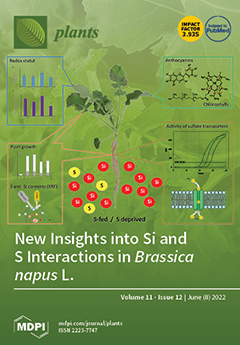Twelve Rho-related proteins (ROPs), namely PbROPs, were identified from the genome of the recently sequenced ‘
Duli’ pear (
Pyrus betulifolia Bunge), a wild-type pear variety routinely used for rootstocks in grafting in China. The length and molecular weight of these proteins
[...] Read more.
Twelve Rho-related proteins (ROPs), namely PbROPs, were identified from the genome of the recently sequenced ‘
Duli’ pear (
Pyrus betulifolia Bunge), a wild-type pear variety routinely used for rootstocks in grafting in China. The length and molecular weight of these proteins are between 175 and 215 amino acids and 19.46 and 23.45 kDa, respectively. The 12
PbROPs are distributed on 8 of the 17 chromosomes, where chromosome 15 has the highest number of 3
PbROPs. Analysis of the deduced protein sequences showed that they are relatively conserved and all have the G domain, insertion sequence, and HVR motif. The expression profiles were monitored by quantitative RT-PCR, which showed that these 12
PbROP genes were ubiquitously expressed, indicating their involvement in growth and development throughout the life cycle of ‘
Duli’ pear. However, they were altered upon treatments with abscisic acid (ABA, mimicking abiotic stress), polyethylene glycol (PEG, mimicking drought), and sodium chloride (NaCl, mimicking salt) to tissue-cultured seedlings. Further, transgenic Arabidopsis expressing
PbROP1,
PbROP2, and
PbROP9 exhibited enhanced sensitivity to ABA, demonstrating that these 3
PbROPs may play important roles in the abiotic stress of ‘
Duli’ pear. The combined results showed that the ‘
Duli’ genome encodes 12 typical ROPs and they appeared to play important roles in growth, development, and abiotic stress. These preliminary data may guide future research into the molecular mechanisms of these 12 PbROPs and their utility in molecular breeding for abiotic stress-resistant ‘
Duli’ pear rootstocks.
Full article






